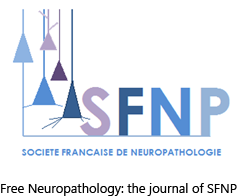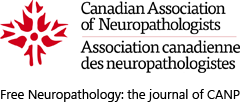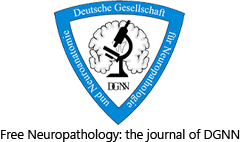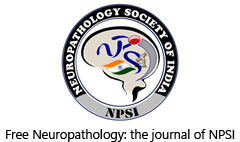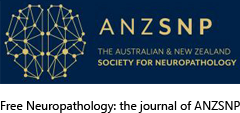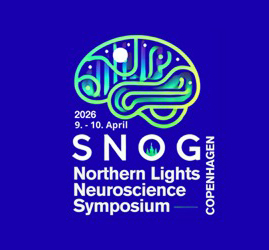Case Reports


We report a central nervous system schwannoma, VGLL-fused in a young man’s frontal lobe. Somatic abnormalities included an EWSR1::VGLL1 fusion, which incorporated the entire translated region of VGLL1, but excluded most domains of EWSR1. The tumor histologically merged with the brain, and showed both schwannoma-like and neuroblastoma-like areas. A germline LZTR1 mutation was subsequently identified, implying the patient suffered from schwannomatosis.

Background: Carotid artery webs (CWs) are an underrecognized cause of ischemic stroke, particularly in younger patients who lack conventional vascular risk factors. CWs are thought to represent an intimal variant of fibromuscular dysplasia (FMD); however, histopathologic data supporting this hypothesis remain limited. We report a case series of three patients with CW-related ischemic stroke who underwent carotid endarterectomy (CEA), allowing for histological analysis of the resected specimens.
Methods: We retrospectively reviewed patients admitted to a Comprehensive Stroke Center between January 2015 and April 2025 with ischemic stroke or transient ischemic attack attributed to an ipsilateral carotid web who subsequently underwent carotid endarterectomy. Clinical data, imaging findings, and histopathologic features were analyzed. All cases met criteria for embolic stroke of undetermined source (ESUS) prior to surgery.
Results: Three patients with CW-related stroke underwent carotid endarterectomy following recurrent events or high embolic risk. In two cases, superimposed thrombi led to initial misdiagnoses such as soft plaque or dissection. Histopathologic analysis consistently demonstrated fibrovascular tissue with intimal fibroid hyperplasia and myxoid degeneration, without lipid-rich plaques or inflammatory infiltrates. No patients experienced recurrent stroke or TIA by the time of their last documented follow-up.
Conclusions: CWs represent a distinct non-atherosclerotic pathology characterized by intimal hyperplasia and myxoid degeneration. Superimposed thrombus may complicate diagnosis, often mimicking plaque or dissection. Advanced imaging, including MR vessel wall imaging and intravascular optical coherence tomography (OCT), can aid in accurate identification. Carotid revascularization may be effective in selected patients, particularly those with recurrence or ESUS. Prospective studies are needed to inform standardized diagnostic and therapeutic strategies.
Methods: We retrospectively reviewed patients admitted to a Comprehensive Stroke Center between January 2015 and April 2025 with ischemic stroke or transient ischemic attack attributed to an ipsilateral carotid web who subsequently underwent carotid endarterectomy. Clinical data, imaging findings, and histopathologic features were analyzed. All cases met criteria for embolic stroke of undetermined source (ESUS) prior to surgery.
Results: Three patients with CW-related stroke underwent carotid endarterectomy following recurrent events or high embolic risk. In two cases, superimposed thrombi led to initial misdiagnoses such as soft plaque or dissection. Histopathologic analysis consistently demonstrated fibrovascular tissue with intimal fibroid hyperplasia and myxoid degeneration, without lipid-rich plaques or inflammatory infiltrates. No patients experienced recurrent stroke or TIA by the time of their last documented follow-up.
Conclusions: CWs represent a distinct non-atherosclerotic pathology characterized by intimal hyperplasia and myxoid degeneration. Superimposed thrombus may complicate diagnosis, often mimicking plaque or dissection. Advanced imaging, including MR vessel wall imaging and intravascular optical coherence tomography (OCT), can aid in accurate identification. Carotid revascularization may be effective in selected patients, particularly those with recurrence or ESUS. Prospective studies are needed to inform standardized diagnostic and therapeutic strategies.

We report the history of a woman who developed four intracranial meningiomas during 11 years of therapy with the synthetic progesterone agonist megestrol. After discontinuation of the drug at age 75 years, she improved clinically and a CT scan showed near complete regression of the meningiomas by 78 years. Autopsy was performed at 83 years of age following an accidental death. At the tumor sites, we found both collagenous tissue with small islands of low grade meningioma having strong nuclear immunoreactivity for progesterone receptor and lipomatous tissue. A literature review showed similar cases of radiologic meningioma regression following discontinuance of progestins. Our case is the first one with histopathologic characterization of the end point.
L-2-hydroxyglutaric aciduria (L-2-HGA) is a rare neurometabolic disorder characterized by accumulation of L2-hydroxyglutarate (L-2-HG) due to mutations in the L2HGDH gene. L-2-HGA patients have a significantly in-creased lifetime risk of central nervous system (CNS) tumors. Here, we present a 16-year-old girl with L-2-HGA who developed a tumor in the right cerebral hemisphere, which was discovered after left-sided neurological defi-cits of the patient. Histologically, the tumor had a high-grade diffuse glioma phenotype. DNA sequencing revealed the inactivating homozygous germline L2HGDH mutation as well as inactivating mutations in TP53, BCOR and NF1. Genome-wide DNA-methylation analysis was unable to classify the tumor with high confi-dence. More detailed analysis revealed that this tumor clustered amongst IDH-wildtype gliomas by methylation profiling and did not show the glioma CpG island methylator phenotype (G-CIMP) in contrast to IDH-mutant diffuse gliomas with accumulated levels of D-2-HG, the stereoisomer of L-2-HD. These findings were against all our expectations given the inhibitory potential of 2-HG on DNA-demethylation enzymes. Our final integrated histomolecular diagnosis of the tumor was diffuse pediatric-type high-grade glioma, H3-wildtype and IDH-wildtype. Due to rapid tumor progression the patient died nine months after initial diagnosis. In this manuscript, we provide extensive molecular characterization of the tumor as well as a literature review focusing on oncogenetic con-siderations of L-2-HGA-associated CNS tumors.
L-2-hydroxyglutaric aciduria (L-2-HGA) is a rare neurometabolic disorder characterized by accumulation of L2-hydroxyglutarate (L-2-HG) due to mutations in the L2HGDH gene. L-2-HGA patients have a significantly in-creased lifetime risk of central nervous system (CNS) tumors. Here, we present a 16-year-old girl with L-2-HGA who developed a tumor in the right cerebral hemisphere, which was discovered after left-sided neurological defi-cits of the patient. Histologically, the tumor had a high-grade diffuse glioma phenotype. DNA sequencing revealed the inactivating homozygous germline L2HGDH mutation as well as inactivating mutations in TP53, BCOR and NF1. Genome-wide DNA-methylation analysis was unable to classify the tumor with high confi-dence. More detailed analysis revealed that this tumor clustered amongst IDH-wildtype gliomas by methylation profiling and did not show the glioma CpG island methylator phenotype (G-CIMP) in contrast to IDH-mutant diffuse gliomas with accumulated levels of D-2-HG, the stereoisomer of L-2-HD. These findings were against all our expectations given the inhibitory potential of 2-HG on DNA-demethylation enzymes. Our final integrated histomolecular diagnosis of the tumor was diffuse pediatric-type high-grade glioma, H3-wildtype and IDH-wildtype. Due to rapid tumor progression the patient died nine months after initial diagnosis. In this manuscript, we provide extensive molecular characterization of the tumor as well as a literature review focusing on oncogenetic con-siderations of L-2-HGA-associated CNS tumors.

Malignant melanotic nerve sheath tumor (MMNST) is a rare and potentially aggressive lesion defined in the 2021 WHO Classification of Tumors of the Central Nervous System. MMNST demonstrate overlapping histologic and clinical features of schwannoma and melanoma. MMNST often harbor PRKAR1A mutations, especially within the Carney Complex. We present a case of aggressive MMNST of the sacral region in a 48-year-old woman. The tumor contained PRKAR1A frameshift pR352Hfs*89, KMT2C splice site c.7443-1G>T and GNAQ p.R183L missense mutations, as well as BRAF and MYC gains. Genomic DNA methylation analysis using the Illumina 850K EpicBead chip revealed that the lesion did not match an established methylation class; however, uniform manifold approximation and projection (UMAP) placed the tumor very near, or with, schwannomas. The tumor expressed PD-L1, and the patient was treated with radiation and immune checkpoint inhibitors following en bloc resection. Although she had symptomatic improvement, she suffered early disease progression with local recurrence, and distant metastases, and died 18 months after resection. It has been suggested that the presence of GNAQ mutations can differentiate leptomeningeal melanocytic neoplasms and uveal melanoma from MMNST. This case and others demonstrate that GNAQ mutations may exist in malignant nerve sheath tumors; that GNAQ and PRKAR1A mutations are not always mutually exclusive and that neither can be used to differentiate MMNST or MPNST from all melanocytic lesions.
Ependymomas have rarely been described to contain pigment other than melanin, neuromelanin, lipofuscin or a combination. In this case report, we present a pigmented ependymoma in the fourth ventricle of an adult patient and review 16 additional cases of pigmented ependymoma from the literature. A 46-year-old female showed up with hearing loss, headaches, and nausea. Magnetic resonance imaging revealed a 2.5 cm contrast-enhancing cystic mass in the fourth ventricle, which was resected. Intraoperatively, the tumor appeared grey-brown, cystic, and was adherent to the brainstem. Routine histology revealed a tumor with true rosettes, perivascular pseudorosettes and ependymal canals consistent with ependymoma, but also showed chronic inflammation and abundant distended pigmented tumor cells that mimicked macrophages in frozen and permanent sections. The pigmented cells were positive for GFAP and negative for CD163 consonant with glial tumor cells. The pigment was negative for Fontana-Masson, positive for Periodic-acid Schiff and autofluorescent, which coincide with characteristics of lipofuscin. Proliferation indices were low and H3K27me3 showed partial loss. H3K27me 3 is an epigenetic modification to the DNA packaging protein Histone H3 that indicates the tri-methylation of lysine 27 on histone H3 protein. This methylation classification was compatible with a posterior fossa group B ependymoma (EPN_PFB). The patient was clinically well without recurrence at three-month post-operative follow-up appointment. Our analysis of all 17 cases, including the one presented, shows that pigmented ependymomas are most common in the middle-aged with a median age of 42 years and most have a favorable outcome. However, one patient that also developed secondary leptomeningeal melanin accumulations died. Most (58.8%) arise in the 4th ventricle, while spinal cord (17.6%) and supratentorial locations (17.6%) were less common. The age of presentation and generally good prognosis raise the question of whether most other posterior fossa pigmented ependymomas may also fall into the EPN_PFB group, but additional study is required to address that question.
Cowden syndrome (CS) is an autosomal dominant hamartoma and tumor predisposition syndrome caused by heterozygous pathogenic germline variants in PTEN in most affected individuals. Major features include macrocrania, multiple facial tricholemmomas, acral and oral keratoses and papillomas, as well as mammary, non-medullary thyroid, renal, and endometrial carcinomas. Lhermitte-Duclos disease (LDD), or dysplastic gangliocytoma of the cerebellum, is the typical brain tumor associated with CS; the lifetime risk for LDD in CS patients has been estimated to be as high as 30%. In contrast, medulloblastoma is much rarer in CS, with only 4 reported cases in the literature. We report a 5th such patient. All 5 patients were diagnosed between 1 and 2 years of age and not all showed the pathognomonic clinical stigmata of CS at the time of their medulloblastoma diagnosis. Where detailed information was available, the medulloblastoma was of the SHH-subtype, in keeping with the observation that in sporadic medulloblastomas, PTEN-alterations are usually encountered in the SHH-subtype. Medulloblastomas can be associated with several tumor-predisposition syndromes and of the 4 medulloblastoma subtypes, SHH-medulloblastomas in children have the highest prevalence of predisposing germline variants (approx. 40%). CS should be added to the list of SHH-medulloblastoma-associated syndromes. Germline analysis of PTEN should be performed in infants with SHH-medulloblastomas, regardless of their clinical phenotype, especially if they do not carry pathogenic germline variants in PTCH1 or SUFU, the most commonly altered predisposing genes in this age-group. In addition, these cases show that CS has a biphasic brain tumor distribution, both in regards to the age of onset and the tumor type: a small number of CS patients develop a medulloblastoma in infancy while many more develop LDD in adulthood.

Atypical teratoid/rhabdoid tumors (AT/RT) are aggressively growing malignant embryonal neoplasms of the central nervous system (CNS), which mainly affect young children. Loss of SMARCB1/INI1 (or SMARCA4 in rare cases) is recognized as the genetic hallmark of AT/RTs and these tumors can be distinguished into three distinct DNA-methylation based molecular subgroups (i.e. -MYC, -SHH and -TYR). While most AT/RTs are considered to occur de novo, previous studies have recognized secondary SMARCB1/INI1-deficient rhabdoid tumors arising from other low grade CNS tumors in young patients. Three AT/RTs, which harbor epigenetic and mutational characteristics of pleomorphic xanthoastrocytoma (PXA), while being entirely void of nuclear SMARCB1/INI1 expression, were recently described in older children. We here report the first case of an AT/RT with molecular features of PXA in a senior patient.
Ependymomas are glial neoplasms with a wide morphological spectrum. The majority of supratentorial ependymomas are known to harbor ZFTA fusions, most commonly to RELA. We present an unusual case of a 9-year-old boy with a supratentorial ependymoma harboring a noncanonical ZFTA-MAML2 fusion. This case had unusual histomorphological features lacking typical findings of ependymoma and bearing resemblance to a primitive neoplasm with focal, previously undescribed myogenic differentiation. We discuss the diagnostic pitfalls in this case and briefly review the histological features of ependymoma with noncanonical gene fusions. Our report underscores the importance of molecular testing in such cases to arrive at the correct diagnosis. Supratentorial ependymomas with noncanonical fusions are rare, and more studies are necessary for better risk stratification and identification of potential treatment targets.
Hydrophilic polymers are commonly used as coatings on intravascular medical devices. As intravascular pro-cedures continue to increase in frequency, the risk of embolization of this material throughout the body has become evident. These emboli may be discovered incidentally but can result in serious complications includ-ing death. Here, we report the first two cases of hydrophilic polymer embolism (HPE) identified on brain tu-mor resection following Wada testing. One patient experienced multifocal vascular complications and diffuse cerebral edema, while the other had an uneventful postoperative course. Wada testing is frequently per-formed during preoperative planning prior to epilepsy surgery or the resection of tumors in eloquent brain regions. These cases demonstrate the need for increased recognition of this histologic finding to enable fur-ther correlation with clinical outcomes.
Cases of acute disseminated encephalomyelitis (ADEM) and its hyperacute form, acute hemorrhagic leukoencephalitis (AHLE), have been reported in coronavirus disease 2019 (COVID-19) patients as rare, but most severe neurological complications. However, histopathologic evaluations of ADEM/AHLE pathology in COVID patients are extremely limited, so far having only been reported in a few adult autopsy cases. Here we compare the findings with an ADEM-like pathology in a pediatric patient taken through a biopsy procedure. Understanding the neuropathology may shed informative light on the autoimmune process affecting COVID-19 patients and provide critical information to guide the clinical management.
The majority of astroblastoma occur in a cerebral location in children and young adults. Here we describe the unusual case of a 38-year-old man found to have a rapidly growing cystic enhancing circumscribed brainstem tumor with high grade histopathology classified as astroblastoma, MN1-altered by methylome profiling. He was treated with chemoradiation and temozolomide followed by adjuvant temozolomide without progression to date over one year from treatment initiation. Astroblastoma most frequently contain a MN1-BEND2 fusion, while in this case a rare EWSR1-BEND2 fusion was identified. Only a few such fusions have been reported, mostly in the brainstem and spinal cord, and they suggest that BEND2, rather than MN1, may have a more critical functional role, at least in these regions. This unusual clinical scenario exemplifies the utility of methylome profiling and assessment of gene fusions in tumors of the central nervous system.
We present a young adult woman who developed a myxoid tumor of the pineal region having a SMARCB1 mutation, which was phenotypically similar to the recently described desmoplastic myxoid, SMARCB1-mutant tumor of the pineal region (DMT-SMARCB1). The 24-year-old woman presented with headaches, nausea, and emesis. Neuroimaging identified a hypodense lesion in CT scans that was T1-hypointense, hyperintense in both T2-weighted and FLAIR MRI scans, and displayed gadolinium enhancement. The resected tumor had an abundant, Alcian-blue positive myxoid matrix with interspersed, non-neoplastic neuropil-glial-vascular elements. It immunoreacted with CD34 and individual cells for EMA. Immunohistochemistry revealed loss of nuclear INI1 expression by the myxoid component but its retention in the vascular elements. Molecular analyses identified a SMARCB1 deletion and DNA methylation studies showed that this tumor grouped together with the recently described DMT-SMARCB1. A cerebrospinal fluid cytologic preparation had several cells morphologically similar to those in routine and electron microscopy. We briefly discuss the correlation of the pathology with the radiology and how this tumor compares with other SMARCB1-mutant tumors of the nervous system.
Infection with the SARS-CoV-2 virus affects a wide range of systems. Significant involvement of the central nervous system has been described, including ischemic and hemorrhagic strokes. Thus far, neuropathologic reports of patients who passed away from COVID-19 have generally described non-specific findings, such as variable reactive gliosis and meningeal chronic inflammatory infiltrates, as well as the consequences of the infection’s systemic complications on the brain, including ischemic infarcts and hypoxic/ischemic encephalopathy. The neuropathological changes in patients with COVID-19 and large hemorrhagic strokes have not been described in detail. We report the case of an elderly male who had a long course of COVID-19 and ultimately passed away from a large intracerebral hemorrhage. In addition to acute hemorrhage, neuropathologic examination demonstrated non-specific reactive changes and chronic periventricular lesions with macrophagic and perivascular lymphocytic infiltrates without evidence of demyelination or presence of SARS-CoV-2 by PCR test. This manuscript expands the spectrum of reported neuropathological changes in patients with COVID-19.







